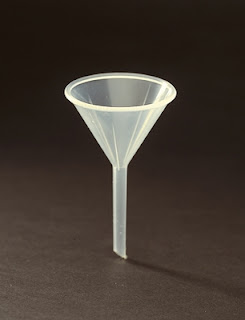A List of Chemistry Laboratory Apparatus and Their Uses
List of Basic Chemistry Apparatus
In most labs, you'll encounter the same basic apparatus. Here, you will find a picture and an explanation for how to use each piece of equipment. You will learn about:
- Safety goggles and safety equipment
- Beakers
- Erlenmeyer flasks, AKA conical flasks
- Florence flasks, AKA boiling flasks
- Test tubes, tongs, and racks
- Watch glasses
- Crucibles
- Funnels
- Graduated cylinders
- Volumetric flasks
- Droppers
- Pipettes
- Burets
- Ring stands, rings, and clamps
- Tongs and forceps
- Spatulas and scoopulas
- Thermometers
- Bunsen Burners
- Balances
The first and foremost rule of any laboratory is to be safe! This may seem obvious, but people often disregard safety protocols for one reason or another, putting themselves and those around them in danger. The best thing you can do is to make sure you follow all safety protocols at all times.
Safety goggles are required wear in all chemistry labs. Not wearing them puts you in danger of eye irritation and possibly blindness in the case of an accident. A small droplet of acid could splash out of the container at any time. Better safe than permanently blinded!
Latex gloves should be used when there is a possibility of corrosive chemicals spilling onto your hands.
A lab apron or coat can also prevent injury in case of spills or splashes.
Never wear open-toed shoes or sandals in a lab.
1)Beakers
A beaker is a common container in most labs. It is used for mixing, stirring, and heating chemicals. Most beakers have spouts on their rims to aid in pouring. They also commonly have lips around their rims and markings to measure the volume they contain, although they are not a precise way to measure liquids. Beakers come in a wide range of sizes.
Because of the lip that runs around the rim, a lid for a beaker does not exist. However, a watch glass (discussed below) can be used to cover the opening to prevent contamination or splashing.
2)
Erlenmeyer flasks, AKA conical flasks
Also known as a conical flask, the Erlenmeyer flask was named after its inventor in 1861. It has a narrow neck and expands toward its base. This allows easy mixing and swirling of the flask without too much risk of spilling. The narrow opening also allows for the use of a rubber or glass stopper. It can easily be clamped to a ring stand (discussed below) as well as heated or shaken mechanically.
Once again, the marks on the side are meant primarily for estimation rather than precision.
An important safety tip here is to never heat this flask while it is capped. This could cause a pressure build-up that could result in explosion.
Florence flasks, AKA boiling flasks
Also known as a boiling flask, the Florence flask has a round bottom and a long neck. It is used to hold liquids and can be easily swirled and heated. It can also easily be capped by rubber or glass stoppers.
Once again, safety dictates that this flask never be heated when capped. Pressure build-up and explosions can and do occur.
Test tube
test tube is a glass tube with one end open and the other end closed. The closed end is rounded. Test tubes are used to hold small samples. They are primarily used for qualitative assessment and comparison. A common place to see these is the biochemistry lab. When a large number of samples need to be tested and compared, test tubes are used to make this easier. They are also easily capped with a rubber or glass stopper.
They are generally held in a test tube rack specifically designed for the purpose. If the test tubes become unsafe to touch with bare hands (whether due to heat or another reason), test-tube tongs can be used to move them.
Never heat a capped test tube.
Watch glass
watch glass is just a round piece of glass that is slightly concave/convex (think of a lens). It can hold a small amount of liquid or solid. They can be used for evaporation purposes and also can function as a lid for a beaker.
crucible is a small clay cup made of a material that can withstand extreme temperatures. They are used for heating substances
FUNNEL
Separating funnel
S.M.panchal science college,Talod
Pic by me
Pic by me
A lab funnel is just like any other funnel except that it was designed to be used in a laboratory setting. They can be made of plastic or glass and can have either a short stem or a long stem, depending on what they are needed for. There are several sizes that can be chosen from based on the amount of liquid that needs to go through them quickly.




























No comments:
Post a Comment